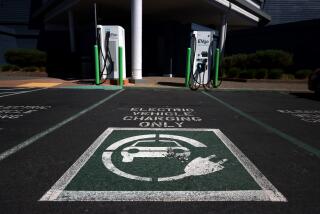The Bill Will Come Later
General Motors Corp. and Ford Motor Co. have once again been murmuring tales of woe into the sympathetic ear of the National Highway Traffic Safety Administration, which administers standards for auto fuel economy. Last year the Big Two were able to get the fuel-efficiency requirement for their 1986 models rolled back, from an average 27.5 miles per gallon to 26 m.p.g. Now they are at it again, asking that their 1987, 1988 and even 1989 models be allowed to meet the same easier standard. The initial response from the traffic safety agency suggests that they have nothing to worry about.
How is it that, 11 years after the fuel-economy law was passed, GM and Ford are still unable to meet its requirements? The companies blame the buying public for preferring their bigger, lower-mileage cars to their smaller, more fuel-efficient models. Sales figures certainly bear that out, but it is a distortion to suggest that fickle public taste is at the root of the GM-Ford predicament.
For what’s clear beyond any cavil is that the public’s appetite for good fuel-efficient cars hasn’t changed since the days of gasoline shortages. That’s a main reason why foreign cars, the overwhelming majority of them highly fuel-efficient, continue to grab a 26% share of the U.S. auto market. It’s a main reason why Japanese imports have been kept under restraint for five years; without those quotas, the foreign market share would have been even bigger. And it’s a main reason why Chrysler has been able to come back from the grave. Chrysler put a lot of its rebuilding investment into greater fuel efficiency, its products found public favor, and as a result it has been able to meet the fuel-economy standards. The public, in short, can’t be accused of having a generic bias against good-mileage cars. It’s just particular about what it buys.
GM and Ford undoubtedly are stuck with a fuel-economy shortfall. One legally allowed remedy is to grant them relief from the 27.5-m.p.g. standard on a finding that it has been either economically impractical or technologically infeasible for them to achieve it. Another legally allowed approach is to penalize their failures with fines, which on this year’s models could total $500 million. Spokesmen for both companies say that rather than pay fines they would shut down production, idling perhaps 100,000 auto workers. To some, this threat might carry the aroma of corporate extortionism. But the traffic safety agency, as it edges toward approving the Big Two request for a rollback, sees it instead as an imperative for acting to save auto industry jobs.
Lowering the standards won’t mean the end of the world. But it will mean that billions of additional gallons of gasoline will be consumed over the lifetimes of the GM and Ford cars sold in this and succeeding model years. It will mean that, in places like Los Angeles, efforts at air-quality improvement will marginally suffer. And it will mean that the significant segment of the public still interested in fuel economy will have no choice but to turn elsewhere, meaning in good part to foreign cars. In the long run that’s not going to do the U.S. auto industry any good. What GM and Ford win now will likely have to be paid for in the future.






